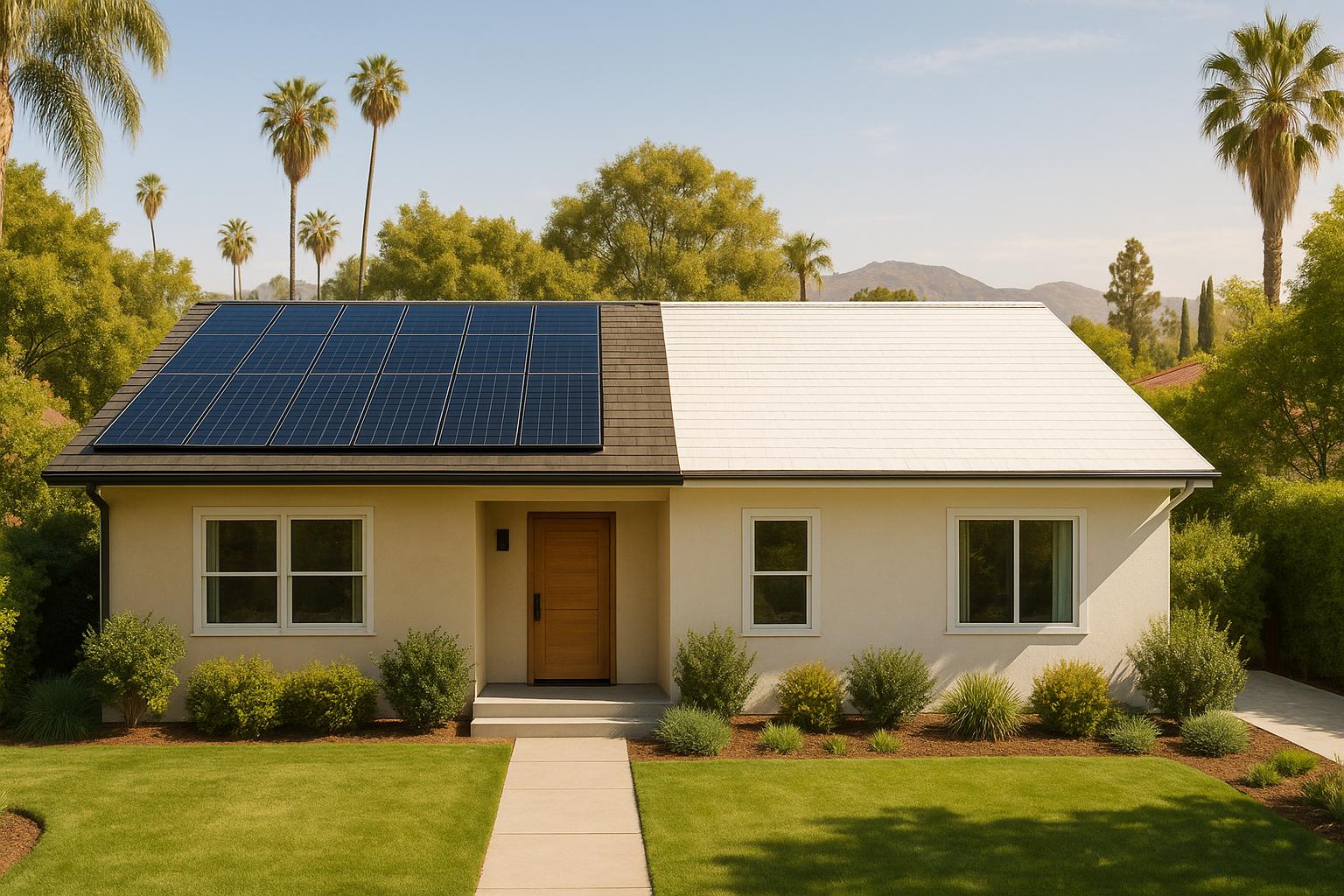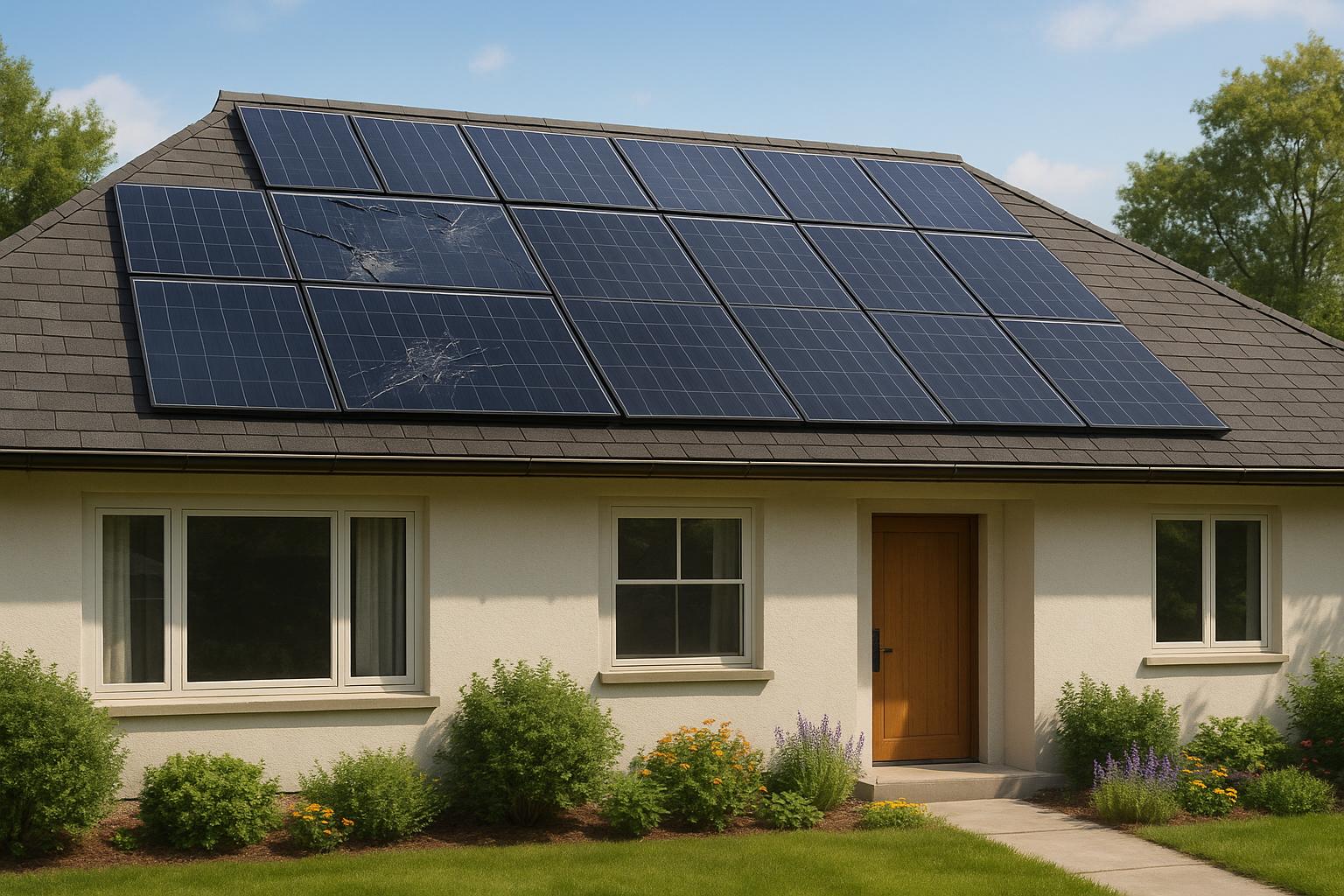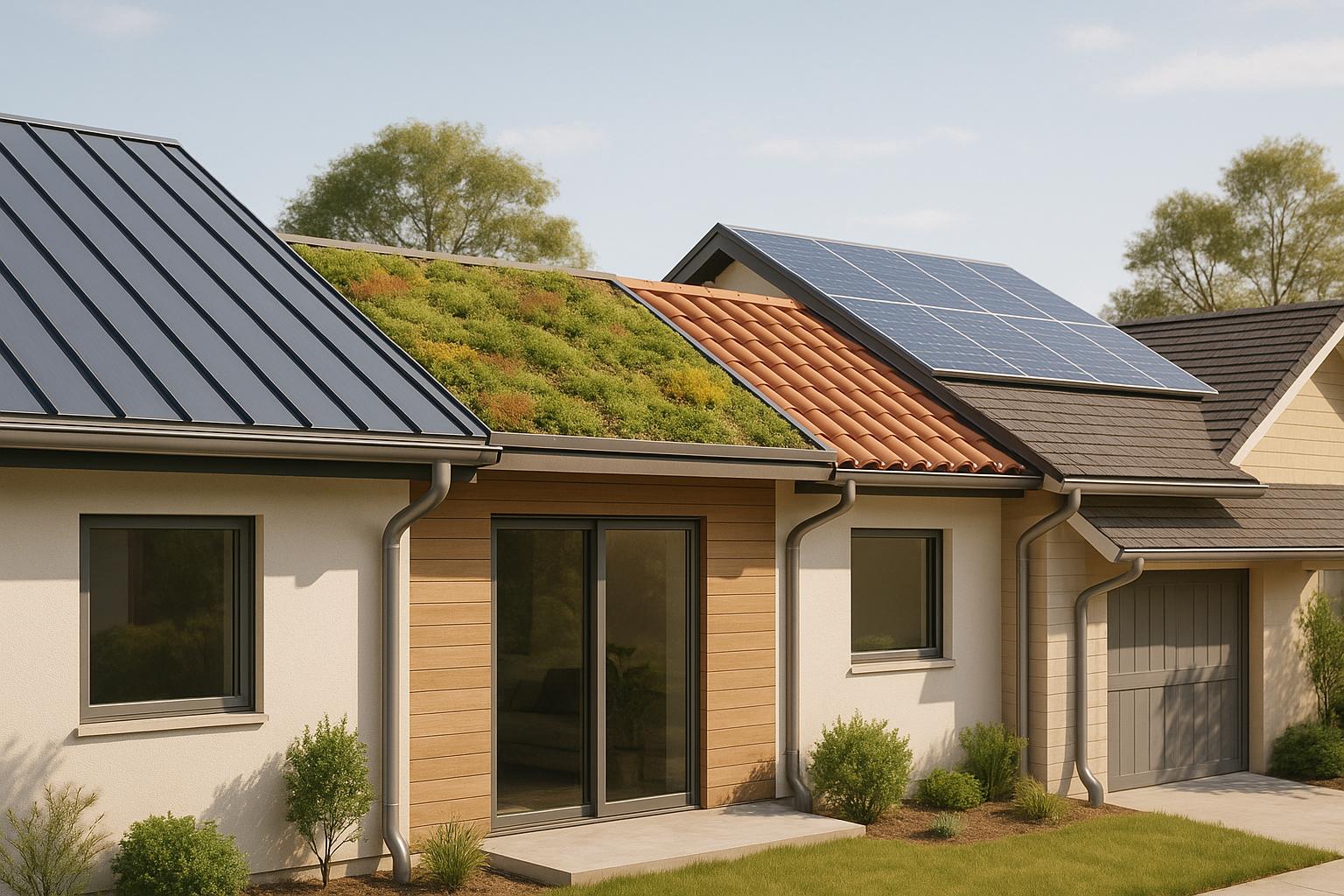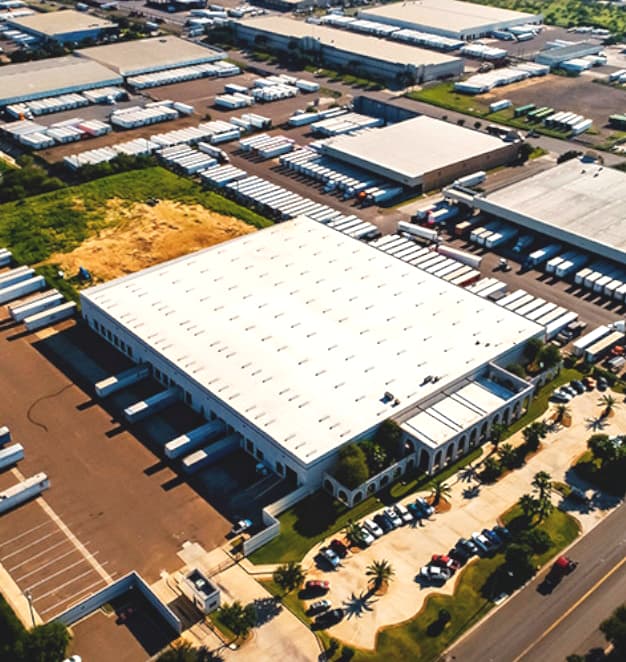Struggling to decide between solar roofs and cool roofs for your LA home? Here’s a quick breakdown to help you choose:
- Solar Roofs: Generate electricity using sunlight, reduce energy bills, and support renewable energy goals. Best for homes with high energy needs and good sun exposure.
- Cool Roofs: Reflect sunlight, lower indoor temperatures, and reduce cooling costs. Ideal for crowded neighborhoods battling heat.
Both options address energy efficiency and heat challenges in Los Angeles, but your choice depends on your property’s needs, energy goals, and budget.
Quick Comparison
| Feature | Solar Roofs | Cool Roofs |
|---|---|---|
| Primary Function | Generates electricity | Reflects sunlight to reduce heat |
| Energy Impact | Reduces grid dependence | Lowers cooling demand |
| Best For | High energy consumption homes | Dense urban areas with heat issues |
| Upfront Cost | Higher | Lower |
Tip: Schedule a professional roofing inspection to determine the best fit for your home.
Solar Roofs vs Cool Roofs: Basic Facts
Solar Roof Basics
Solar roofs are equipped with photovoltaic (PV) panels that transform sunlight into electricity. These systems combine roofing materials with PV panels to generate DC electricity, which is then converted to AC by an inverter. Many modern setups include features like energy storage, monitoring systems, and grid connectivity. They are specifically designed to handle the climatic conditions of Los Angeles.
Cool Roof Basics
Cool roofs are designed to reflect sunlight and release absorbed heat, helping to lower indoor temperatures. These roofs are available in various forms suitable for Los Angeles, such as reflective single-ply membranes, treated metal surfaces, built-up roofs with light-colored aggregates, and modified bitumen sheets with reflective granules. Proper installation ensures they reduce roof surface temperatures and limit heat transfer indoors.
| Feature | Solar Roofs | Cool Roofs |
|---|---|---|
| Primary Function | Generates electricity | Reflects sunlight to reduce heat uptake |
| Energy Impact | Contributes to renewable power | Lowers cooling demand by reducing heat |
| Environmental Benefit | May lower carbon emissions | Reduces the urban heat island effect |
These features illustrate how solar and cool roofs address distinct environmental challenges in Los Angeles. Understanding these differences is key to assessing their roles in energy efficiency and urban heat management.
Impact on Climate and Energy
How Solar Roofs Save on Energy Bills
Solar roofs use sunlight to generate electricity, which means less dependence on traditional power grids and lower monthly energy bills. They not only help homeowners save money but also contribute to Los Angeles’ shift toward cleaner energy sources.
How Cool Roofs Help Reduce City Heat
Cool roofs are designed to reflect sunlight and absorb less heat. This keeps buildings cooler during hot days, reduces the need for air conditioning, and cuts cooling costs. Plus, by reflecting heat, they help combat the urban heat island effect, making neighborhoods across Los Angeles more comfortable. These combined benefits make it easier to compare the advantages of solar and cool roofing options in the city.
Solar, Cool, And Green Roofs, How Do They Compare?
sbb-itb-d1d6490
Which Roof Works Best in LA?
Los Angeles’ sunny climate and dense urban environment call for roofing options that address both energy efficiency and environmental concerns. Solar and cool roofs each have their strengths, and the right choice often depends on the specific features of your property.
Solar Roof Requirements and Costs
With LA’s abundant sunshine, solar roofs can be a smart investment. To get the most out of them, it’s important to assess factors like roof orientation, potential shading, and the overall condition of your roof. While solar roofs can deliver long-term savings on energy bills, they do come with significant upfront costs, making a professional evaluation a must. As Tony Mirzakhanyan, Head of Prime American Roofing, explains:
"Working in a professional and responsible team is essential for delivering high-quality roofing services. Collaboration ensures that each aspect of the project, from initial assessment to final installation, is executed with precision and expertise".
If solar roofs aren’t the right fit, cool roofs offer another compelling option.
Cool Roof Options and Savings
Cool roofs are designed to reflect sunlight, reducing indoor temperatures and lowering cooling costs. This feature is particularly helpful in densely populated areas, where the urban heat island effect can make temperatures soar. Multi-unit buildings, in particular, can see noticeable energy savings due to reduced cooling demands.
Choosing the Best Roof for Your LA Property
The choice between a solar roof and a cool roof often comes down to your property’s unique characteristics. For single-family homes with higher energy needs, solar roofs can provide substantial benefits. On the other hand, properties in crowded neighborhoods may gain more from the cooling effects of a reflective roof. Scheduling a professional roofing inspection can help you evaluate your specific needs and make the best decision for your LA property.
Direct Comparison
Building on the earlier discussion of energy insights and basic facts, let’s compare how solar and cool roofs address urban challenges in Los Angeles.
Solar vs. Cool Roof Features
| Feature | Benefit for LA Properties |
|---|---|
| Solar Roofs | Generates renewable energy using LA’s sunlight |
| Cool Roofs | Lowers cooling needs in densely populated areas |
Solar roofs take full advantage of Los Angeles’ sunny climate to produce renewable energy. They help reduce reliance on the energy grid, offering potential long-term savings and increased property value.
Cool roofs, on the other hand, are designed to reflect sunlight and limit heat absorption. This feature is particularly effective in combating the urban heat island effect, which is a growing concern in crowded city areas.
Your choice depends on your goals – whether you prioritize energy independence or improved cooling. For expert installation and advice tailored to Los Angeles properties, Prime American Roofing is a go-to provider in Southern California.
This comparison lays the groundwork for exploring specific needs and costs for LA homeowners.
Conclusion
Deciding between solar and cool roofs in Los Angeles comes down to your property’s specific needs and energy goals. Solar roofs take advantage of the city’s abundant sunshine to produce renewable energy, while cool roofs help reduce urban heat and cut cooling expenses.
Here are some key points to think about:
- Property Evaluation: Check roof orientation and structural strength.
- Energy Goals: Decide whether energy production or heat reduction is your priority.
- Cost Considerations: Weigh upfront costs against potential long-term savings.
- Environmental Impact: Factor in how the choice supports LA’s environmental goals.
For homeowners interested in sustainable roofing, expert advice can make all the difference. Prime American Roofing provides free roof inspections to help identify the best solution for your property.
Both solar and cool roofs play a role in advancing Los Angeles’s environmental efforts, offering distinct benefits tailored to different property needs and energy plans.
FAQs
Which is better for my Los Angeles home: a solar roof or a cool roof?
Choosing between a solar roof and a cool roof for your Los Angeles home depends on your priorities and property features. Solar roofs are ideal if you want to generate renewable energy and reduce electricity costs, while cool roofs are better suited for reflecting heat and lowering indoor temperatures, especially in LA’s warm climate.
Factors like your home’s energy needs, roof structure, and budget will play a key role in the decision. Consulting with roofing professionals can help you evaluate your options and determine the best solution for your home.
What are the long-term financial advantages of choosing a solar roof over a cool roof for your Los Angeles home?
The long-term financial benefits of a solar roof often outweigh those of a cool roof, especially in sunny cities like Los Angeles. A solar roof generates electricity, which can significantly reduce your energy bills over time. Additionally, homeowners may qualify for federal tax credits, local incentives, and net metering programs, further increasing savings.
On the other hand, a cool roof reflects sunlight and reduces heat absorption, lowering cooling costs during hot summers. While it doesn’t generate electricity, it can extend the lifespan of your roof by minimizing heat-related wear and tear.
When deciding between the two, consider your budget, energy needs, and long-term goals. Solar roofs offer greater financial returns through energy production, while cool roofs provide immediate savings on cooling costs and are typically less expensive upfront.
How does the urban heat island effect impact the performance of cool roofs in Los Angeles neighborhoods?
The urban heat island effect, where densely populated areas experience higher temperatures due to heat absorption by buildings and pavement, makes cool roofs especially effective in Los Angeles. Cool roofs are designed to reflect more sunlight and absorb less heat, which helps reduce indoor temperatures and cooling costs in such environments.
In Los Angeles, where summer temperatures often soar, cool roofs can significantly lower energy consumption and improve comfort in homes. They also contribute to reducing the overall urban heat island effect by minimizing heat retention in neighborhoods.





